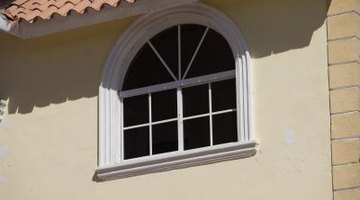What Is the Best Way to Seal an Opening Between the Top of an Exterior Wall & an Overhang?
Your home must be properly sealed to prevent moisture from seeping inside and causing damage. Openings between your exterior wall and your roof can allow water to run into your home. Air leaks can also allow outdoor air to enter your home, causing your heating and cooling system to work harder.
Causes

Small gaps between your exterior wall and roof overhang could cause problems as time goes on. These gaps may have been left unsealed during construction or they could occur over time. Your roof overhang should extend at least 3/4 to 1 inch beyond your roof to keep water from running inside your walls. Downspouts that are clogged are also a common cause of water leaking into small gaps. Gutters can rot and develop holes that allow moisture to leak, as well.
Effects
When water leaks inside your home through gaps or cracks in the exterior wall, structural damage can occur. Interior walls may develop yellow or brown water stains that are difficult to remove. Constant moisture will cause drywall to deteriorate and crumble, requiring removal and repair. If the gaps are not sealed and water continues to come inside your home, mold growth may eventually occur. Mold growth can cause unsightly black, green or brown stains on your walls that must be removed to avoid the adverse health effects associated with mold exposure. Air can also come inside through gaps and cracks, making the humidity level in your home higher. When air leaks are not properly sealed, it reduces the effectiveness of your insulation.
Sealing
According to the United States Department of Energy, sealing gaps in your home with caulk can prevent both water and air from leaking inside your home. Silicone construction caulk will seal exterior building materials, such as brick, stone and metal. Completely fill all visible gaps with caulk and dry with a cloth. You can place strips of foam board insulation on the inside of your attic to keep moisture from coming in openings between your wall and roof overhang. As well as creating a barrier from air and moisture, foam board insulation will increase the energy efficiency of your home.
Considerations
Once you have sealed the opening in your wall, you should look around your home for other areas that could be allowing air and moisture inside. Inspect your gutters for debris or leaves that could allow water to accumulate and run into your home. Flush your gutters routinely with water to remove leaves. If your downspouts do not carry water at least 20 feet away from your home, place extensions on them to direct water farther away from your home.
Writer Bio
Tracy Hodge has been a professional writer since 2007. She currently writes content for various websites, specializing in health and fitness. Hodge also does ghostwriting projects for books, as well as poetry pieces. She has studied nutrition extensively, especially bodybuilding diets and nutritional supplements.
Photo Credits
- Photos.com/Photos.com/Getty Images
More Articles



